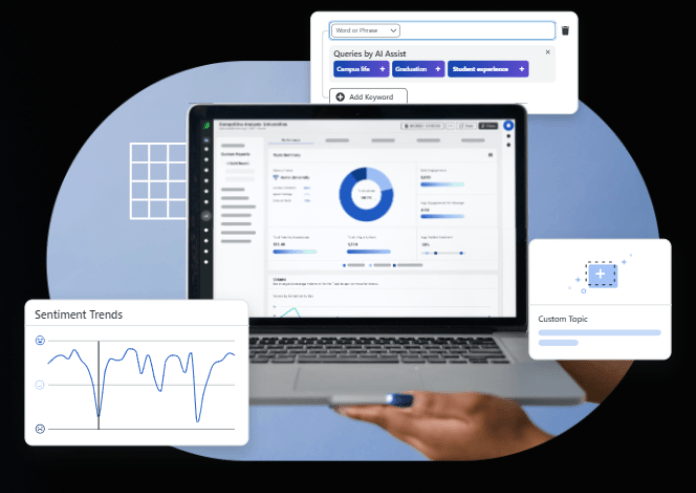Your business operates in a competitive environment, and you want to know how you measure up. That’s where share of voice (SOV) comes in. SOV will help you determine your position within the market. It’s a metric that puts all your social media, paid media, and other initiatives into context so you understand where your brand stands.
Is your business being mentioned in relevant conversations? Do consumers see you as the industry leader? Do you feature in the media? Share of voice will answer the questions and be the starting point for you to fortify your efforts and lead the pack.
What is share of voice?
Share of voice is the metric that offers your business insights into your brand awareness in comparison to the competition. Although this blog focuses on the digital SOV, share of voice hails back to the pre-digital era.
SOV traditionally measures your share of advertising on print, radio, or TV compared to competitors in your market.
Now, share of voice includes all measurable brand awareness — online mentions, pay-per-click (PPC) campaigns, site traffic for keywords, media coverage, and beyond.
The digital era has made measuring share of voice slightly easier. Using the right tools makes calculating SOV straightforward, and from this data, you can clarify your position among competitors.
Share of voice is a valuable metric to measure and has been linked to market share and revenue growth, giving you and idea of the profit margins of the competition compared to your own.
Why is it important to track share of voice?
It is vital to measure share of voice to see your business in the big picture. This context gives your performance data another dimension, opening the way for greater opportunities and ways to scale. Evaluating share of voice delivers various benefits:
- Enriched audience insights: SOV metrics give you a deeper understanding of your audience or prospects. For example, with social media SOV, you can extract insights from authentic platform conversations. You can determine why consumers are picking you over competitors or where you can improve positioning. Your business may be the go-to place because of your customer service or pricing. Share of voice metrics helps you identify untapped audience segments and what your business can do to attract new segments.
- Optimized competitor research: Measuring SOV will give you insight into what your competitors are up to. These insights give you the strategic advantage to set your brand apart based on strengths and weaknesses. You can see which of your competitors dominate conversations in the industry, how you stack up against them, and where conversations happen. This data is invaluable in strengthening your marketing efforts.
- Enhanced brand management: Tracking and managing share of voice data indicates how many conversations are happening around your brand and the sentiment underpinning them. Sentiment allows you to monitor brand reputation and take proactive measures if negative trends surround your campaigns.
- Refined campaigns: Share of voice measurement offers opportunities to improve your campaigns. You can measure your SOV and the SOV of competitor campaigns running simultaneously. You can analyze audience-specific insights, filtering them by country, language, or platform to comprehensively understand what resonates with your audience. You can also replicate positive encounters and improve your success and market share.
- Boosted public relations (PR) efforts: Reviewing your share of voice on the news in comparison with competitors will indicate how effective your media strategy is. Consider outlets covering your competitors and not you. Also, are there specific stories media gravitate towards that you can maximize in future content goals?
How do you calculate share of voice?
You can measure share of voice seamlessly with tools or, in some cases, manually. To get your SOV, divide your brand metrics by the total market metrics. Then, multiply this number by 100 to get a percentage.
Here’s how to calculate share of voice for various forms of marketing:
1. Share of voice and media
SOV of the media is known as the voice of the industry metric. You’re measuring how established your brand is among industry peers and in the media. This calculation helps evaluate your content strategy and PR initiatives and finding opportunities for you to expand your efforts.
Most social listening tools crawl blogs and news websites, accurately estimating your media share of voice.

2. Share of voice and social media
Social media delivers an “authentic” share of voice metric because the actual voice of the customer is what you’ll be measuring, as well as how often consumers talk about you organically on platforms. You can calculate social media SOV manually or through a paid listening tool.
Manual calculations still require you to use free tools, and you won’t be able to measure sentiment, reach, and metrics surrounding influencers. You can calculate your mentions and how many mentions your competitors are getting. To measure SOV this way, divide your mentions by competitor mentions and multiply by 100. You’ll need to do this for each competitor.
Consider using a social media listening tool to dive deeper and uncover invaluable insights. A listening tool will help you create alerts for keywords like your brand name, social media handles, and other targeted keywords. These tools give you enhanced data to compare your SOV with competitors.
3. Share of voice and PPC
Marketing professionals traditionally used share of voice to measure share of advertisements on TV, radio, and print. The same principle works for PPC. With Google Ads statistics measuring share of voice, it’s easy to check.
The PPC share of voice metric you’ll want to focus on is impression share, or the number of times your ads could’ve been shown based on your campaign and keyword settings. Google calculates impression share by dividing your impressions by the total number of relevant impressions.
What metrics can you measure with SOV?
Metrics you can measure for share of voice include:
- PPC keywords
- Organic keywords
- Reach
- Impressions
- Revenue
- Hashtags
- Mentions
Get the most out of your initiatives by connecting with specialists
Share of voice may be complex, but it is also an invaluable metric for scaling your business and fortifying your marketing efforts. Measuring SOV is highly individualized. You’ll need to calculate SOV in different areas of your digital marketing initiatives to create a launchpad for your marketing and business strategy. By calculating and analyzing your SOV, you can pinpoint what’s working for your organization and potential growth opportunities.
Ready to measure your share of voice and turn insights into sound marketing decisions? The expert SEO.com team has over 25 years of experience helping businesses uncover insights and make data-driven decisions to boost revenue. Contact us online to learn more about maximizing your share of voice metrics.
Don’t fail your website’s most important test
Get an SEO scorecard of your website for free in less than 30 seconds.
$3bn+
revenue driven for clients



Add WebFX to your content marketing toolbox today
Get SEO ProposalTable of Contents
- What is Share of Voice?
- Why is It Important to Track Share of Voice?
- How Do You Calculate Share of Voice?
- 1. Share of Voice and Media
- 2. Share of Voice and Social Media
- 3. Share of Voice and PPC
- What Metrics Can You Measure with SOV?
- Get the Most out of Your Initiatives by Connecting with Specialists
$3bn+
revenue driven for clients



Add WebFX to your content marketing toolbox today
Get SEO Proposal

